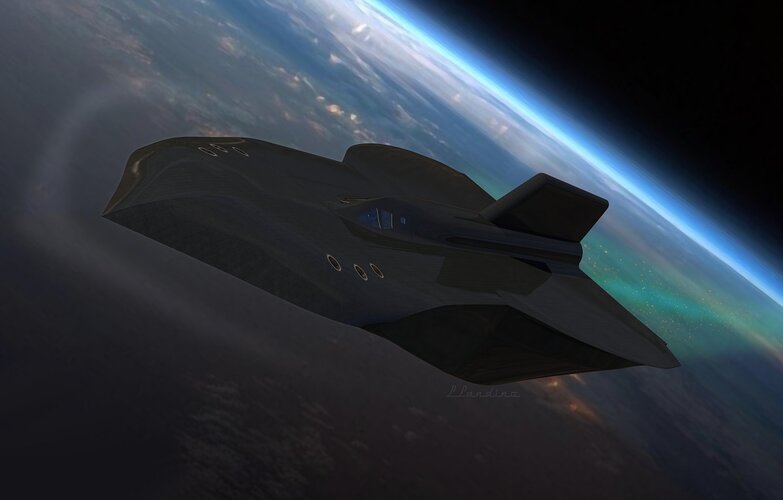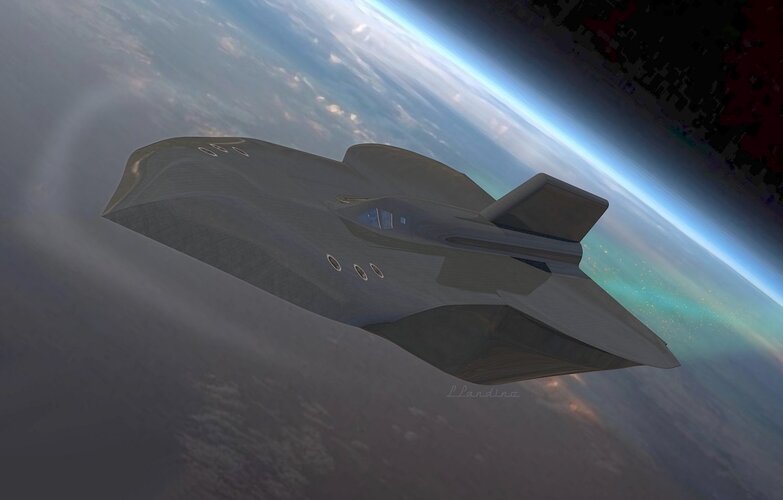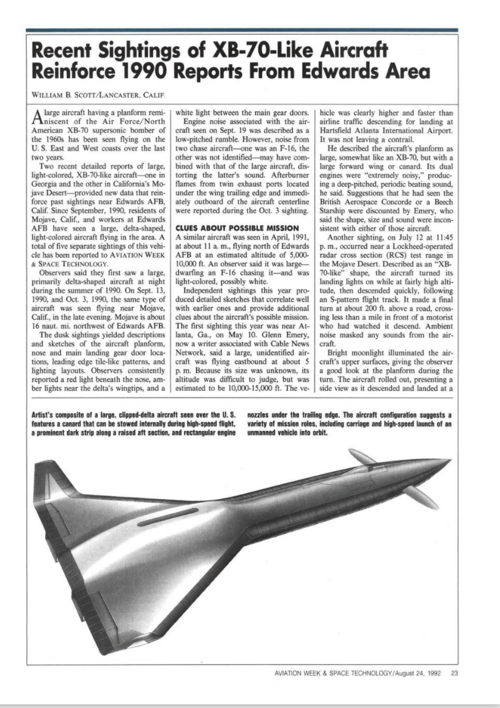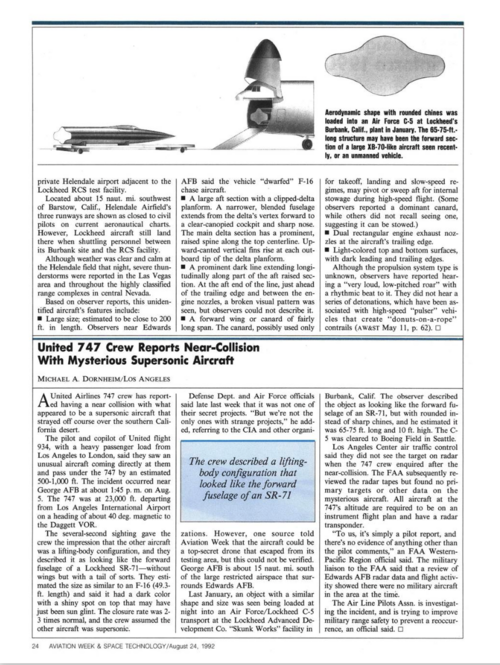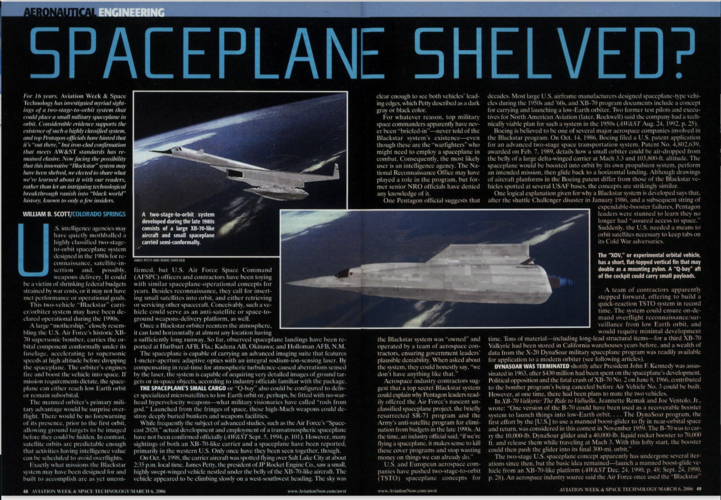Randy, you don't believe there was ever any operational Mothership/TSTO type system or high-speed successor to the SR-71?
The SR-71 was retired for a variety of practical and political reasons. Was that a good idea? Maybe not, but it happened. It does not necessarily follow that the Blackbird would then be replaced by another high-speed, high-altitude platform. At the time, a combination of satellites, subsonic high-altitude platforms, and UAVs were available to provide overhead reconnaissance coverage. The idea of a Blackstar-type vehicle was very appealing to fans of exotic aerospace vehicles but, nevertheless, appears to have been a fantasy.
And yet we still hear occasionally about the upcoming "SR-72" coming "soon" be it an unmanned, occasionally manned or fully manned platform. Why? Because it pays to pitch what the "customer" wants to hear and unfortunately the actual 'customer" in this case is Congress rather than the military. Probably the worst part about it all is then the MILITARY has to make noises on why the idea is a "good" one to help encourage Congress to spend at least SOME money on assets they actually need which quickly becomes a self-licking-ice-cream-cone
Mike Dornheim, the senior West Coast editor of Aviation Week & Space Technology magazine thought the Blackstar article was crap. He told me it had so many flaws that he believed it should not have been published, but he had no choice in the matter. He elected not to try to fix any of those flaws so that knowledgeable people would spot them and, perhaps, provide appropriate feedback to the publisher.
"Though the magazine is ill," said Dornheim, "it may respond to outside assistance, which is often more effective than inside complaining."
Subsequently, several excellent rebuttal articles by Dwayne Day, Jeffrey Bell, and others, appeared online and elsewhere.
Dornheim added, "At the moment the powers-that-be think they have done a wonderful thing with the Blackstar story. Website traffic [quadrupled] and [Scott's article] is being discussed [online]."
AW&ST Executive Vice President and Publisher Ken Gazzola wrote to Bill Scott:
"Congratulations on your vintage AW&ST 'black program' cover story this week. This is a prime example among many which sets AW&ST far ahead of the rest."
Dornheim commented, "I worry that so encouraged, there may be more to come. Wiser views need to be brought in."
I agreed with Dornheim and worried that Scott's Blackstar article was a combination of yellow journalism and junk science.
It's nice to hear there was internal opposition however as you note it had internal support because it 'got views' which is unfortunately the way news cycles work these days.
With no documentation to back it up, it was no more than a collection of unverifiable anecdotes and rumors. Despite Scott's claim that "considerable evidence supports the existence of" the Blackstar system, he included no such evidence in his article. Although he admitted that "iron-clad confirmation that meets AW&ST standards has remained elusive," he claimed that a number of details about the project were hard facts.
Worse as the cited article shows he also keeps doubling-down on the same subject getting even wilder with even less evidence. And heartbreakingly the sources that are cited are taken uncritically with no proper background work. (I again shudder at the "Salt Lake City" reference... Yes it bothers me, how could you tell
He described a two-stage to orbit (TSTO) system and asserted that "the spaceplane can reach low earth orbit," but he seemed to have no real understanding of orbital mechanics. It would have been nice to have had at least one rocket scientist review the article prior to publication.
I'm gonna point out that while the article is junk some (and only some and only if you squint in a certain context
Essentially what I'm pointing out is yes in fact you COULD have a TSTO "spaceplane" system capable of reaching orbit from a Mach 3 start. Systems like "Black Horse" have shown the math works even without some 'excotic' boron based propellant. (Frankly you can do it with peroxide and jet fuel, methane and LOX or even RP1 and LOX) But it needs to be done in a 'system' that was designed to work together from the start and not something that looks like fan-art and is described in a nonsensical word salad.
The fact that he uses so many 'technical terms' that actually exist but are not applicable the way he implies is physically painful.
The entire section on "adaptive optics with an integral sodium-ion-sensing laser" was not scientifically accurate. Such a system would be useful for ground-based telescopes, not the other way around.
Case in point
Scott wrote, "Many sightings of both an XB-70-like carrier and a spaceplane have been reported." Without photographic proof those claims were, at best, just UFO reports. We have no meaningful way of knowing what, if anything, the alleged witnesses saw. Could you really keep "observed spaceplane landings" at Hurlburt Field, Kadena Air Base, and Holloman AFB a secret?
No, you couldn't and despite the "Red 3" alert that would only make the incident MORE known! We once had an SR-71 at Eglin AFB and the only reason anyone (generally) knew about it was because the base paper managed to get a photo of its tail. (On which had been written "Eglin AFB" and "EG" in aircraft soap.... The aircrafts "overnight" stay turned into a solid week of washes and several demotions and non-judicial punishments...)
The Blackstar system is allegedly so secret that top military space commanders apparently have never been "briefed-in" -- never told of the Blackstar's existence -- even though these are the warfighters who might need to employ a spaceplane in combat. So, what good is it?
You've seen "Spy's Like Us" haven't you
More seriously it's possible that such would not have an operational "need to know" but unlikely. More to the point in order to be any use it would have be 'operational' which in and of itself requires a pretty vast network of operations and maintenance activities that can't be easily hidden and would not be from those 'top commanders'.
If is was ONLY a test article and never actually deployed, (and the articles say differently) then it would not have been in wide use, would not have been 'deployed' in places around the world and would certainly not have been 'seen' as many times and places as claimed. Hence you have a direct conflict between it's "deep black" status and it's supposed operational nature.
Scott claimed an unnamed Pentagon official suggested that Blackstar was owned and operated by "a team of aerospace contractors" to provide government leaders with plausible deniability. They don't really need deniability if the system hasn't been publicly surfaced. They can simply respond to questions with a 'no comment.'"
Worse is that having the system operated by such a "team" would be a security nightmare since it would seem to be operated by that team AT and AROUND military bases (and over major population centers for some reason... still "Salty" about that one
Having a contractor-owned system certainly wouldn't give plausible deniability in the event that the vehicle's missions were exposed. If the missions of Blackstar included reconnaissance, satellite deployment, satellite retrieval or servicing, anti-satellite or space-to-ground weapons delivery, then government officials could hardly claim that a team of civilian contractors took such action on their own initiative.
Plausible deniability is why we have the alphabet soup of agencies involved in reconnaissance that we do. As for giving ACTUAL "plausible deniability" there isn't really any such thing. Whether operated directly by the government or a 'government contractor' the responsibility is the same.
Additionally, Scott's suggestion that Blackstar was developed to provide assured access to space in the wake of the Challenger and expendable vehicle failures of 1986/1987 flies in the face of logic. Why cobble together an unproven and likely hazardous vehicle configuration from 1960s-era technology (XB-70 and X-20 DynaSoar) rather than simply fix the relatively minor (by comparison) problems with the existing space launch fleet?
He also claimed it needed a "boron fuel" breakthrough which itself flies in the face of credibility. As you say the 'system' is essentially late 60s technology which while "known" is hardly something you can 'throw together' especially with a well known and understood to be not very useful "fuel" needing to be re-developed as well.
Randy

